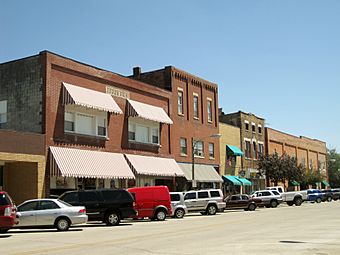Downtown Peotone Historic District facts for kids
Quick facts for kids |
|
|
Downtown Peotone Historic District
|
|
 |
|
| Location | Roughly North First Street and both sides of North Second Street, roughly bounded by the alley south of Main and north by North Street Peotone, Will County, Illinois, U.S. |
|---|---|
| Architectural style | Late 19th and Early 20th Century Movements, Queen Anne |
| NRHP reference No. | 05001253 |
| Added to NRHP | November 16, 2005 |
The Downtown Peotone Historic District is a special collection of 42 buildings in Peotone, Illinois. It's like a time capsule! Thirty-seven of these buildings are important because they show how the area looked and felt in the past.
Peotone's Early Days
Peotone started growing in 1856 when the Illinois Central Railroad arrived. This train line connected the town to other places. Just two years later, the first shop opened its doors. People quickly moved to the area.
By 1865, Peotone was a busy place. It had a windmill, a post office, and even an opera house. There was also a trolley system and several large buildings called grain elevators. These elevators stored crops from local farms. Peotone was also home to the Will County Fair back then.
How Peotone Grew
The land around Peotone was very good for farming. This meant many farmers and merchants (people who sold goods) lived there. Most businesses were first located on Railroad Street. Their storefronts faced the train tracks.
Later, businesses started moving to Second Street. Many shops on Railroad Street just added new fronts to the back of their buildings. An electric power plant opened in Peotone in 1894. Street lights were added later that same year. A water tower was built in 1895. Sidewalks were put in place in 1902.
Changes Over Time
A part of the district on Main Street was destroyed by a fire in 1913. But it was quickly rebuilt just one year later. The village trolleys were quite useful. They carried passengers from Chicago all the way south to Kankakee.
In the 1920s, a big company called Continental Bridge Company was a major employer. They built many bridges across the United States and Canada. They also provided steel for ships. However, new building projects stopped in the 1930s. This was due to the Great Depression, a time when the economy was very bad. The town's growth never fully recovered after that.
Building Styles and History
The first buildings in Peotone were mostly simple vernacular structures. They were built using wood frames. After the big fire, people started using stronger materials like masonry (brick or stone).
Almost all the buildings in this historic district were once used for businesses. The Downtown Peotone Historic District was officially added to the National Register of Historic Places on November 16, 2005. This means it's recognized as an important historical place.



